COIT20249 IT Professional Practice: 3D Printing Analysis Portfolio
VerifiedAdded on 2023/06/12
|5
|782
|279
Portfolio
AI Summary
This portfolio provides an analysis of the impact of 3D printing technology on IT professional practice, focusing on its disruptive effects on supply chains and various industries. It includes annotations of two key research articles, the first examining 3D printing's impact on supply chain flexibility, adaptability, and potential security concerns, and the second exploring the broader implications of 3D printing across technical and non-technical sectors, highlighting ethical considerations and future business opportunities. The portfolio recommends incorporating improvements to product design and addressing security and privacy concerns within the technology. It further suggests analyzing legal and ethical considerations related to 3D printers to mitigate future risks and ensure proper management.
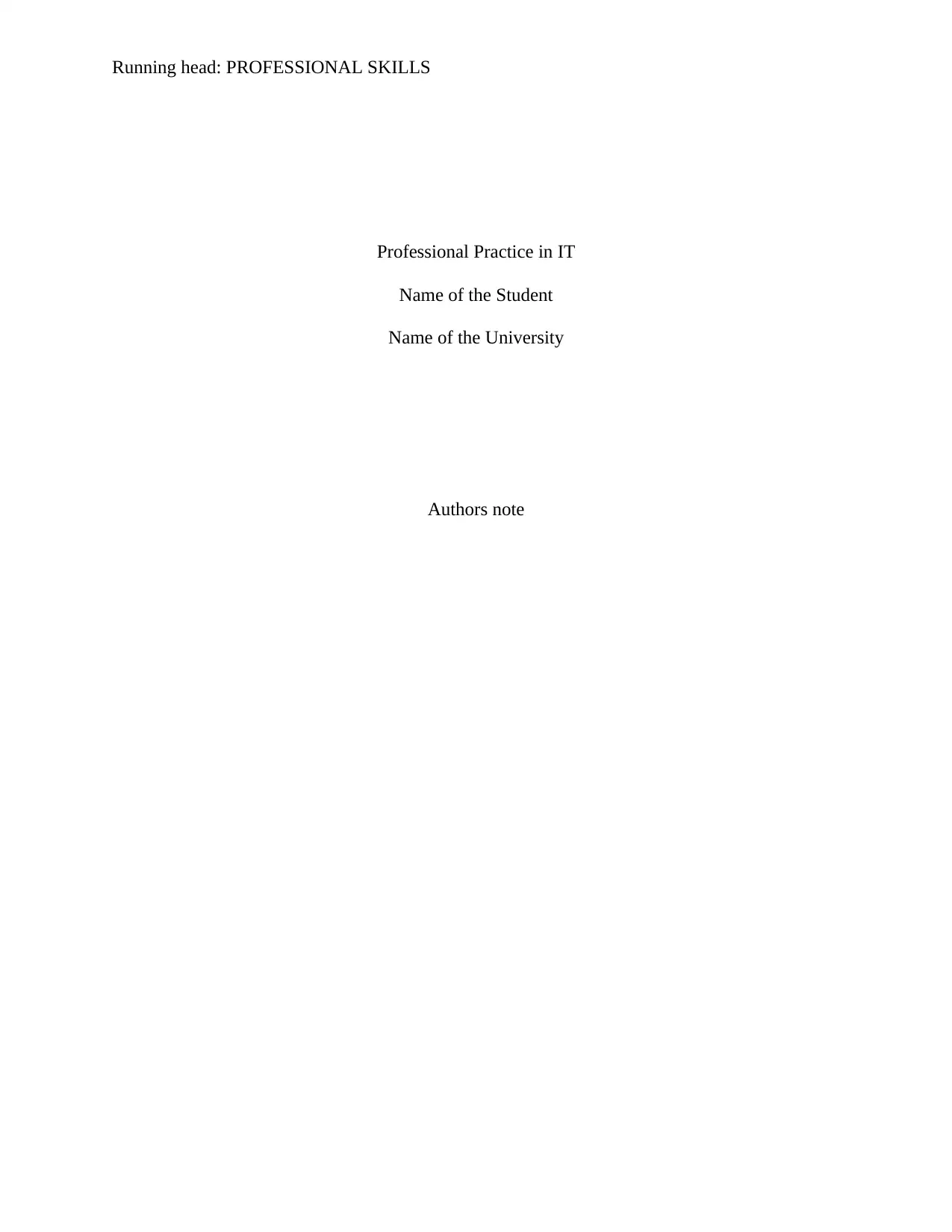
Running head: PROFESSIONAL SKILLS
Professional Practice in IT
Name of the Student
Name of the University
Authors note
Professional Practice in IT
Name of the Student
Name of the University
Authors note
Paraphrase This Document
Need a fresh take? Get an instant paraphrase of this document with our AI Paraphraser
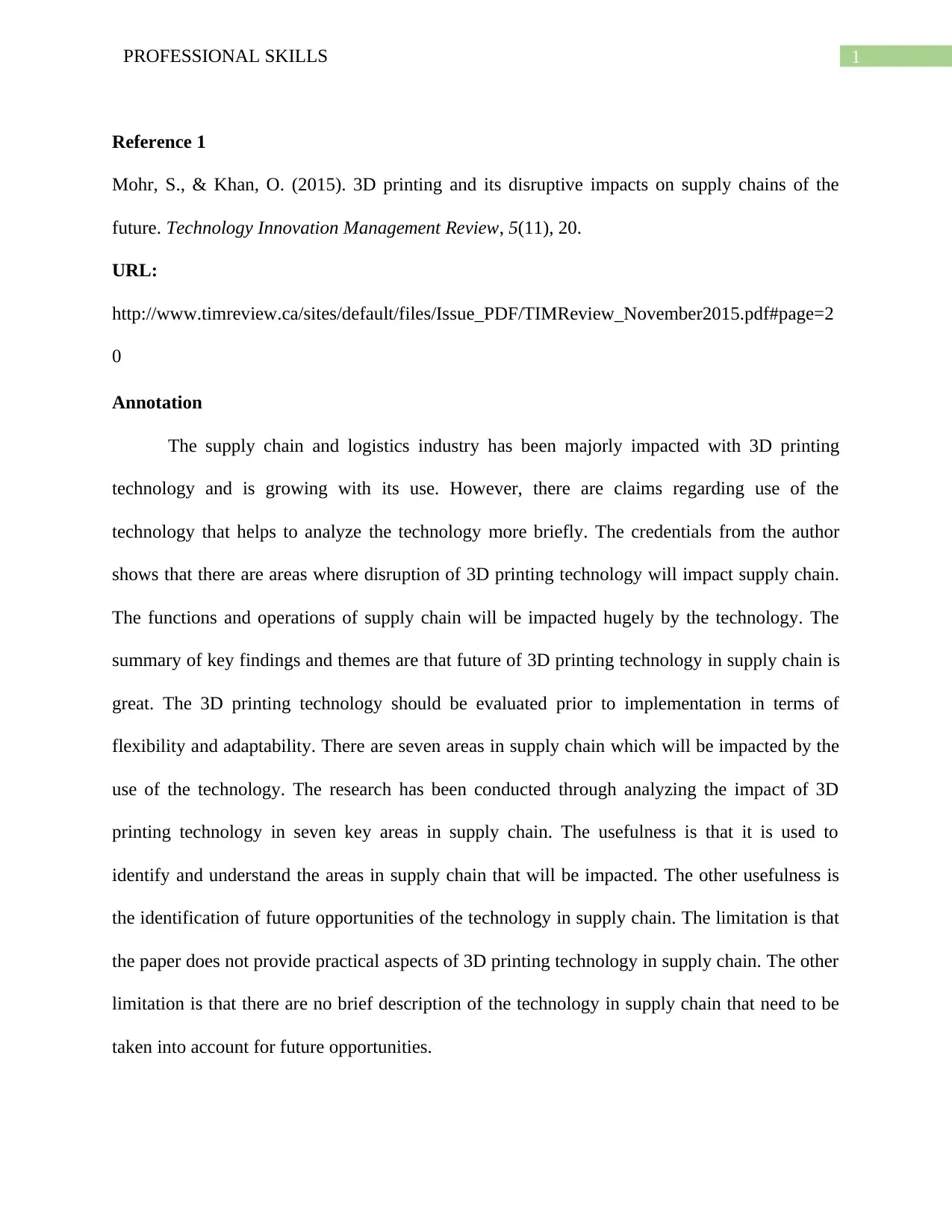
1PROFESSIONAL SKILLS
Reference 1
Mohr, S., & Khan, O. (2015). 3D printing and its disruptive impacts on supply chains of the
future. Technology Innovation Management Review, 5(11), 20.
URL:
http://www.timreview.ca/sites/default/files/Issue_PDF/TIMReview_November2015.pdf#page=2
0
Annotation
The supply chain and logistics industry has been majorly impacted with 3D printing
technology and is growing with its use. However, there are claims regarding use of the
technology that helps to analyze the technology more briefly. The credentials from the author
shows that there are areas where disruption of 3D printing technology will impact supply chain.
The functions and operations of supply chain will be impacted hugely by the technology. The
summary of key findings and themes are that future of 3D printing technology in supply chain is
great. The 3D printing technology should be evaluated prior to implementation in terms of
flexibility and adaptability. There are seven areas in supply chain which will be impacted by the
use of the technology. The research has been conducted through analyzing the impact of 3D
printing technology in seven key areas in supply chain. The usefulness is that it is used to
identify and understand the areas in supply chain that will be impacted. The other usefulness is
the identification of future opportunities of the technology in supply chain. The limitation is that
the paper does not provide practical aspects of 3D printing technology in supply chain. The other
limitation is that there are no brief description of the technology in supply chain that need to be
taken into account for future opportunities.
Reference 1
Mohr, S., & Khan, O. (2015). 3D printing and its disruptive impacts on supply chains of the
future. Technology Innovation Management Review, 5(11), 20.
URL:
http://www.timreview.ca/sites/default/files/Issue_PDF/TIMReview_November2015.pdf#page=2
0
Annotation
The supply chain and logistics industry has been majorly impacted with 3D printing
technology and is growing with its use. However, there are claims regarding use of the
technology that helps to analyze the technology more briefly. The credentials from the author
shows that there are areas where disruption of 3D printing technology will impact supply chain.
The functions and operations of supply chain will be impacted hugely by the technology. The
summary of key findings and themes are that future of 3D printing technology in supply chain is
great. The 3D printing technology should be evaluated prior to implementation in terms of
flexibility and adaptability. There are seven areas in supply chain which will be impacted by the
use of the technology. The research has been conducted through analyzing the impact of 3D
printing technology in seven key areas in supply chain. The usefulness is that it is used to
identify and understand the areas in supply chain that will be impacted. The other usefulness is
the identification of future opportunities of the technology in supply chain. The limitation is that
the paper does not provide practical aspects of 3D printing technology in supply chain. The other
limitation is that there are no brief description of the technology in supply chain that need to be
taken into account for future opportunities.
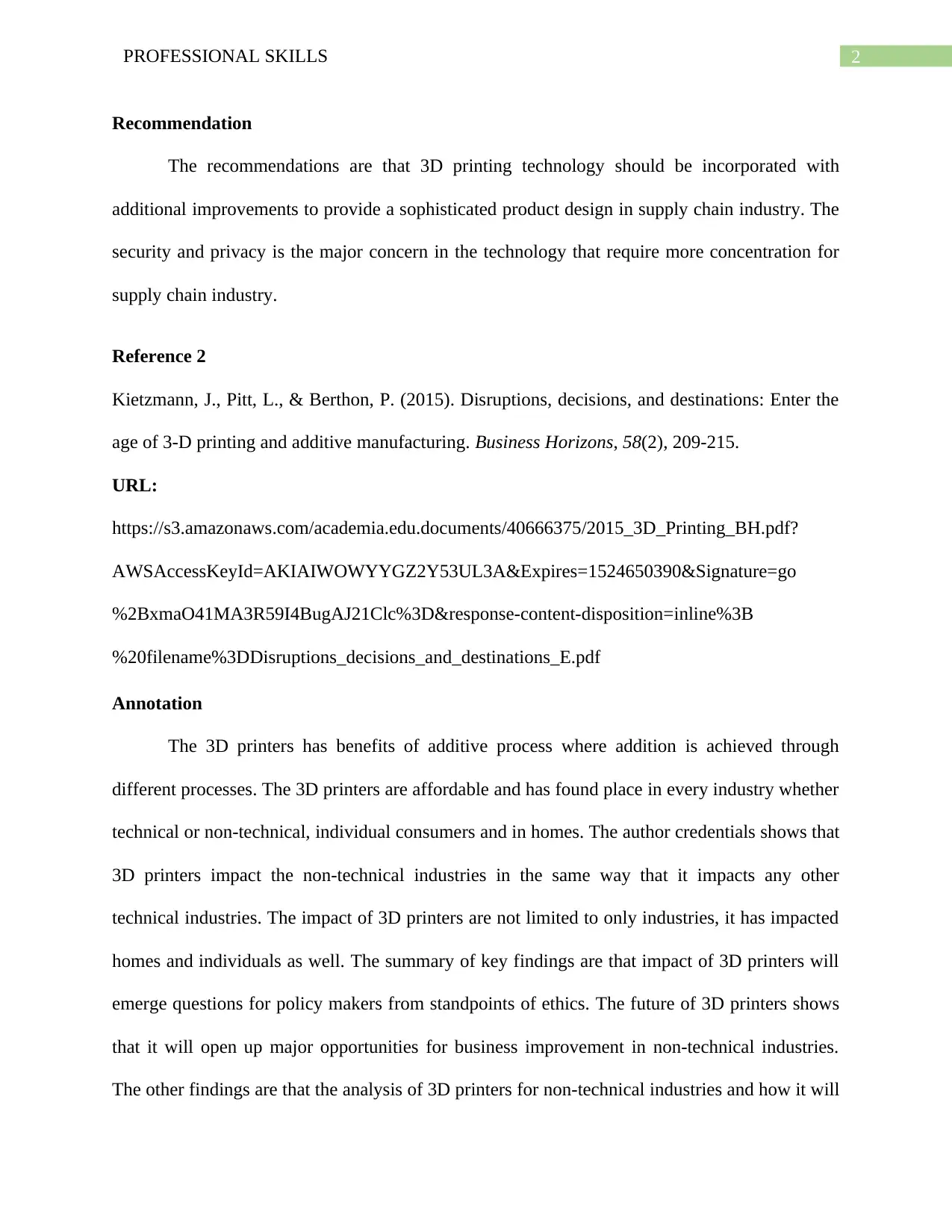
2PROFESSIONAL SKILLS
Recommendation
The recommendations are that 3D printing technology should be incorporated with
additional improvements to provide a sophisticated product design in supply chain industry. The
security and privacy is the major concern in the technology that require more concentration for
supply chain industry.
Reference 2
Kietzmann, J., Pitt, L., & Berthon, P. (2015). Disruptions, decisions, and destinations: Enter the
age of 3-D printing and additive manufacturing. Business Horizons, 58(2), 209-215.
URL:
https://s3.amazonaws.com/academia.edu.documents/40666375/2015_3D_Printing_BH.pdf?
AWSAccessKeyId=AKIAIWOWYYGZ2Y53UL3A&Expires=1524650390&Signature=go
%2BxmaO41MA3R59I4BugAJ21Clc%3D&response-content-disposition=inline%3B
%20filename%3DDisruptions_decisions_and_destinations_E.pdf
Annotation
The 3D printers has benefits of additive process where addition is achieved through
different processes. The 3D printers are affordable and has found place in every industry whether
technical or non-technical, individual consumers and in homes. The author credentials shows that
3D printers impact the non-technical industries in the same way that it impacts any other
technical industries. The impact of 3D printers are not limited to only industries, it has impacted
homes and individuals as well. The summary of key findings are that impact of 3D printers will
emerge questions for policy makers from standpoints of ethics. The future of 3D printers shows
that it will open up major opportunities for business improvement in non-technical industries.
The other findings are that the analysis of 3D printers for non-technical industries and how it will
Recommendation
The recommendations are that 3D printing technology should be incorporated with
additional improvements to provide a sophisticated product design in supply chain industry. The
security and privacy is the major concern in the technology that require more concentration for
supply chain industry.
Reference 2
Kietzmann, J., Pitt, L., & Berthon, P. (2015). Disruptions, decisions, and destinations: Enter the
age of 3-D printing and additive manufacturing. Business Horizons, 58(2), 209-215.
URL:
https://s3.amazonaws.com/academia.edu.documents/40666375/2015_3D_Printing_BH.pdf?
AWSAccessKeyId=AKIAIWOWYYGZ2Y53UL3A&Expires=1524650390&Signature=go
%2BxmaO41MA3R59I4BugAJ21Clc%3D&response-content-disposition=inline%3B
%20filename%3DDisruptions_decisions_and_destinations_E.pdf
Annotation
The 3D printers has benefits of additive process where addition is achieved through
different processes. The 3D printers are affordable and has found place in every industry whether
technical or non-technical, individual consumers and in homes. The author credentials shows that
3D printers impact the non-technical industries in the same way that it impacts any other
technical industries. The impact of 3D printers are not limited to only industries, it has impacted
homes and individuals as well. The summary of key findings are that impact of 3D printers will
emerge questions for policy makers from standpoints of ethics. The future of 3D printers shows
that it will open up major opportunities for business improvement in non-technical industries.
The other findings are that the analysis of 3D printers for non-technical industries and how it will
⊘ This is a preview!⊘
Do you want full access?
Subscribe today to unlock all pages.

Trusted by 1+ million students worldwide
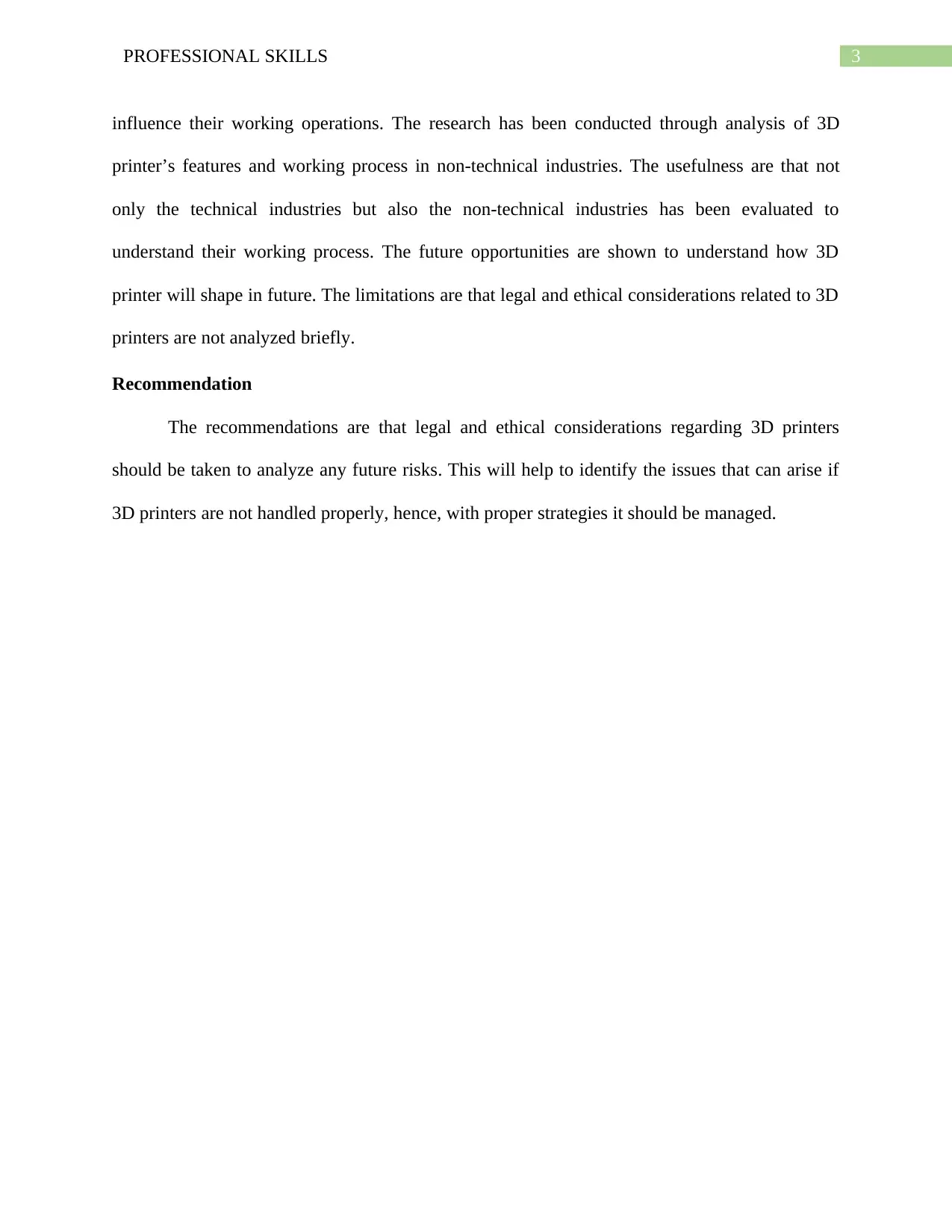
3PROFESSIONAL SKILLS
influence their working operations. The research has been conducted through analysis of 3D
printer’s features and working process in non-technical industries. The usefulness are that not
only the technical industries but also the non-technical industries has been evaluated to
understand their working process. The future opportunities are shown to understand how 3D
printer will shape in future. The limitations are that legal and ethical considerations related to 3D
printers are not analyzed briefly.
Recommendation
The recommendations are that legal and ethical considerations regarding 3D printers
should be taken to analyze any future risks. This will help to identify the issues that can arise if
3D printers are not handled properly, hence, with proper strategies it should be managed.
influence their working operations. The research has been conducted through analysis of 3D
printer’s features and working process in non-technical industries. The usefulness are that not
only the technical industries but also the non-technical industries has been evaluated to
understand their working process. The future opportunities are shown to understand how 3D
printer will shape in future. The limitations are that legal and ethical considerations related to 3D
printers are not analyzed briefly.
Recommendation
The recommendations are that legal and ethical considerations regarding 3D printers
should be taken to analyze any future risks. This will help to identify the issues that can arise if
3D printers are not handled properly, hence, with proper strategies it should be managed.
Paraphrase This Document
Need a fresh take? Get an instant paraphrase of this document with our AI Paraphraser
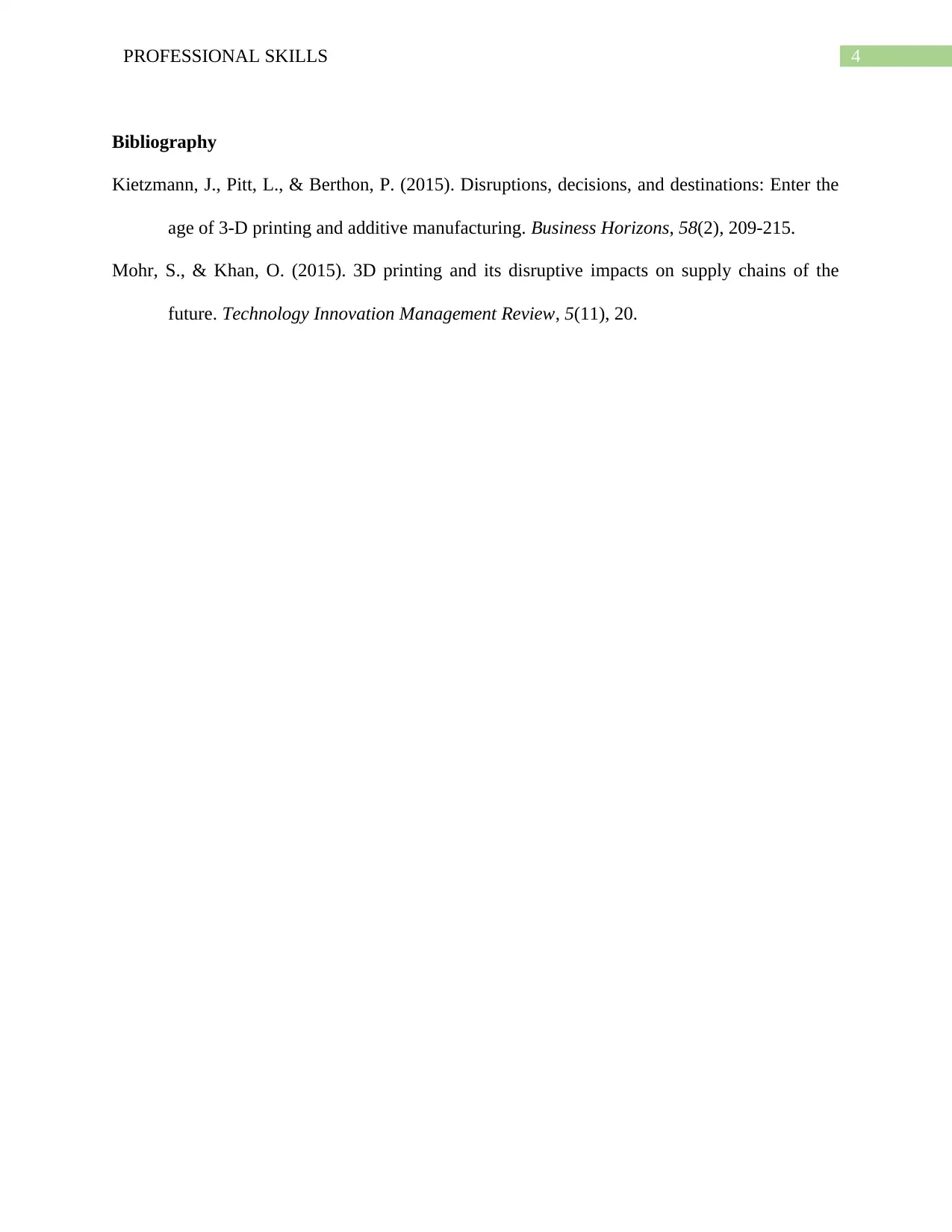
4PROFESSIONAL SKILLS
Bibliography
Kietzmann, J., Pitt, L., & Berthon, P. (2015). Disruptions, decisions, and destinations: Enter the
age of 3-D printing and additive manufacturing. Business Horizons, 58(2), 209-215.
Mohr, S., & Khan, O. (2015). 3D printing and its disruptive impacts on supply chains of the
future. Technology Innovation Management Review, 5(11), 20.
Bibliography
Kietzmann, J., Pitt, L., & Berthon, P. (2015). Disruptions, decisions, and destinations: Enter the
age of 3-D printing and additive manufacturing. Business Horizons, 58(2), 209-215.
Mohr, S., & Khan, O. (2015). 3D printing and its disruptive impacts on supply chains of the
future. Technology Innovation Management Review, 5(11), 20.
1 out of 5
Related Documents
Your All-in-One AI-Powered Toolkit for Academic Success.
+13062052269
info@desklib.com
Available 24*7 on WhatsApp / Email
![[object Object]](/_next/static/media/star-bottom.7253800d.svg)
Unlock your academic potential
Copyright © 2020–2025 A2Z Services. All Rights Reserved. Developed and managed by ZUCOL.





